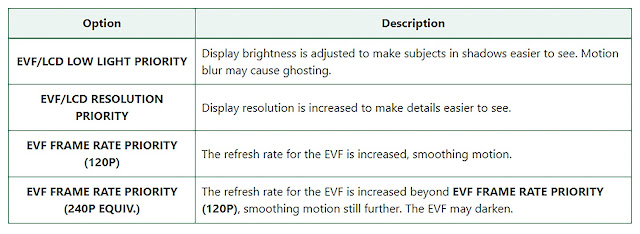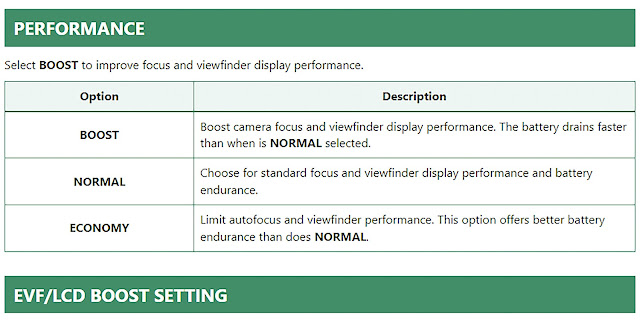How much EVF/LCD lag is there in a Fujifilm X-H2S? How much time elapses between the actual event and when you see it? The answer seems to always be, "It depends."
Fujifilm provides four different EVF/LCD 'use case' settings. Each serving a different purpose. Those four settings are:
I didn't test the Boost, Normal or Economy modes as I have never used any but the Boost mode.
That said, I set up a rudimentary test to determine how much EVF/LCD lag there is in each of the four EVF/LCD settings shown the top illustration. I set my iPhone on a stand, put the X-H2S on a tabletop tripod in front of it, then set the appropriate menu setting. For each of the four settings, using another camera, I made five exposures showing the difference in time between the iPhone's screen and the LCD. I then averaged them. It is easy to see the difference between the time shown on the stopwatch and the time shown on the LCD. See the image at the top of this post for an example.
Here is the average time lag I found for the four settings:
EVF/LCD Low Resolution Priority 0.023 seconds or 23 milliseconds
EVF/LCD Resolution Priority 0.013 seconds or 13 milliseconds
EVF Frame Rate Priority (120P) 0.036 seconds or 36 milliseconds
EVF Frame Rate Priority (240P Equiv.) 0.027 seconds or 27 milliseconds
I don’t know about you but I can live with from 13 to 36 milliseconds lag time when trying to time a photograph. In fact, I’m absolutely fine with it. I know that my reaction time or reflex time is longer than that. If you need lag les than 13/1000ths of a second, you must have amazing reaction time!
I need to point out one thing that may or may not be important. The third and fourth settings speak only to the EVF whereas the first and second speak to both the EVF and LCD. These tests were conducted looking at the LCD. I don't know if the EVF shows any difference for the third and fourth settings. I have no way of capturing what is showing inside the EVF simultaneously while showing my phone in the background.
So, take this for what you feel its worth. The reason I conducted this little test was because I was impressed with the 'blackout free' EVF when I was photographing fast moving subjects. I was curious to better understand how much of a delay there was in actuality even with a blackout free viewfinder.
I ran the same test with my Nikon Z7II. I will have that for you in my next post.
Join me over at my website, https://www.dennismook.com.
Thanks for looking. Enjoy!
Dennis A. Mook
All content on this blog is © 2013-2022 Dennis A. Mook. All Rights Reserved. Feel free to point to this blog from your website with full attribution. Permission may be granted for commercial use. Please contact Mr. Mook to discuss permission to reproduce the blog posts and/or images.



No comments:
Post a Comment